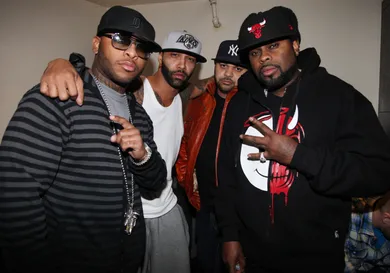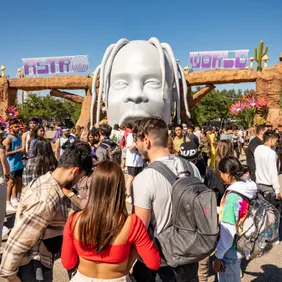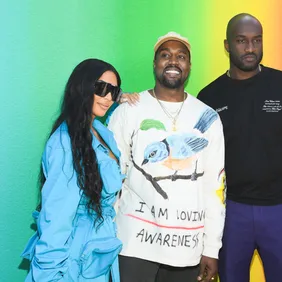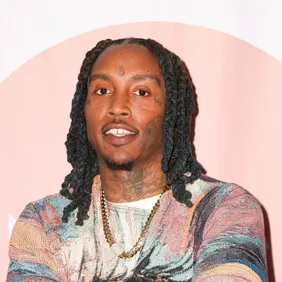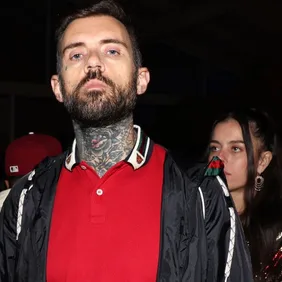The mixtape deities were certainly smiling upon the Earth when Slaughterhouse first assembled. They do love their carnage. For some backstory, it was 2008. The new era of mixtape dominance was on the horizon with a wealth of future superstars eyeing their respective debuts. In the underworld, however, several wily veterans were reaping the spoils of a creative apex.
Royce Da 5’9”, then coming off the creation of his acclaimed Bar Exam tape (a series that we’ll explore further in another piece), had developed the habit of obliterating any track on his doorstep. With that came a noted sense of competitive spirit, fueled by his deadly addiction to Patron. Joe Budden was in the midst of building the type of resume that would one day place him in a viral list’s top three greatest rappers of all time, mission accomplished. Brooklyn’s Joell Ortiz was coming off a brief but short-lived stint on Dr. Dre’s Aftermath Entertainment, a testament to his artistic pedigree. And Death Row veteran Crooked I’s modus operandi remained as it had always been, unadulterated bars delivered in unparalleled fashion. It’s easy to find a common thread.
Though their paths seldom crossed as collaborators, Joe Budden would ultimately prove to be the glue on his album Halfway House. The four would unite, along with the “Pete Best” of the bunch Nino Bless, developing chemistry that would merit further discussion. Unfortunately for Bless, the other four decided to move on as a unit, using their mixtape hunger and lyrical prowess as a guiding light. Eventually, they would go on to release their eponymous debut in 2009, enlisting go-to producers like Emilie, The Alchemist, DJ Khalil, and Mr. Porter. Stylistically, the polished music of Slaughterhouse seemed far removed from the seminal track, which prompted concerns of label appeasement; consider half-hearted pop-rap single “The One,” which seemed tailor-made for misguided radio play.
And yet there was something to work with. For such effortless bar-spitters, the act of rapping was akin to a child blowing a snot bubble. It would take more than the occasional listless instrumental to derail the gleeful carnage laid on wax. Though it’s risky to make inferences, reaching the heights of their respective solo work seemed to take a backseat in favor of riding their competitive streak to its logical conclusion -- whatever that may have been. Eventually, perhaps through his affiliation with Royce Da 5’9, Eminem found himself drawn in by the group’s dynamic. With the seeds of Bad Meets Evil: Hell The Sequel already in the works, Em linked with Slaughterhouse for a Recovery bonus track called “Session One,” the first collaboration between the group and their soon-to-be label boss. From that moment onward, speculation of a major label partnership blossomed; was Em not the perfect fit, given his own appreciation for the art of lyricism? After much theorizing, the deal was sealed in 2010 alongside a new posse cut called “Shady 2.0.”
A match made in heaven on paper. Yet the prospect of crafting a Shady Records debut for such a talented and explosive group of personalities would be no easy feat. Though albums like Cheers and Get Rich Or Die Tryin’ have stacked Shady’s pedigree, Slaughterhouse was going in under different circumstances. For one, each emcee had already developed a creative process far removed from Em’s own. And secondly, the major label politics inherent within the Interscope umbrella would be a major culture shock for the independent rappers -- particularly Joe Budden, who once found himself creatively stifled during his tenure at Def Jam. Where an independent artist can deliver on a whim, free of that old devil micromanagement, a cog in the machine must play by certain rules. Consider the idea of “the radio single,” a foreign concept to the typical underground dweller; it’s likely that Joe Budden still shudders at the mere sight of a pump, let alone the movie poster for Pixar’s Up. Still, with a Shady deal comes unspoken agreements, in that mainstream marketability was not to be ignored. Not to mention, a major label budget the likes of which the group had never seen.
So why then, was their Shady debut Welcome To Our House met with such a lukewarm response? And more importantly, was it justified?
Johnny Nunez/WireImage/Getty Images
A HOUSE DIVIDED
Seeing as the response to Welcome To Our House has been well documented it seems fitting to examine some more recent takes from the creators. For starters, executive producer Eminem, whose shoulders burdened the bulk of Joe Budden’s blame. Slim opened up about his reaction to the tepid reactions during a Kamikaze-centric interview with Sway. “We did Welcome To Our House, and that was another album that came out like: holy shit, people literally just trashed this,” said Em. “It was a huge fucking backlash, like ‘this isn’t what we want to hear, it’s too polished.’ Listen. You’re critiquing these guys who are fucking wordsmiths.”
“To me, the beats were crazy on that album,” reflects Em. “Only thing I did was added my little touch, adding music and mixing to bring out the production a little bit. I don’t know if I did any actual beats on there. All I heard was the backlash it was too polished.” Contrast that with Joe Budden’s heated take, which to be fair, arose in the wake of being dissed on Kamikaze. “Every time we had to go do five or six more songs, it was always mad Eminem beats,” ranted Joe, on his Podcast. “They were horrible! They were horrible fucking beats. They were bad fucking beats, man!”
On that note, consider the production roster: Alex Da Kid, Hit-Boy, T-Minus, AraabMuzik, No I.D, StreetRunner, Mr. Porter, Boi-1da, and Streetrunner. A solid group, including a few recurring voices from their independent debut. As for Eminem (a divisive producer) he only contributed slight touches by his own admission. All the while, he seemed positive that the group were crafting something to be proud of. “I wanted them to be huge, man, I really did,” laments Em. “A group that lyrical, to fucking bust through everything. It definitely hurt my feelings a lot when the album didn’t do good. When we got Cee-Lo on the hook, I thought this might be out of here.” Unfortunately, one of the recurring critiques levied on the project is the commercialized aesthetic, itself a betrayal of the underground spirit that forged them. The beats do little to dull that particular narrative, as many of the instrumentals employ up-tempo synthesizers and bombastic, borderline anthemic hooks.
Johnny Nunez/WireImage/Getty Images
Consider that Slaughterhouse’s typical approach to structure consisted of four gargantuan verses strung together. As none of the members were particularly adept at crafting hooks, it left a glaring hole in the songwriting. A hole filled by the aforementioned Cee-Lo, by Skylar Grey, by an underutilized and rabid Busta Rhymes. Gone were the simplistic instrumentals designed for unadulterated bars, and with that marked the departure of the group’s biggest source of competition. They found themselves unified in the name of crafting concise songs, which often led to abridged verses and adherence to pre-existing concepts. Even when the group seems to be having fun like on “Throw That,” the verses come and go before momentum has room to grow. When they do have time to flex, like on introductory cut “Our House,” their anchored by the track’s dominant theme of overcoming adversity. That’s not to say inserting cohesion into their music was a bad idea per se, but it did expose some of the growing pains.
The group’s roots aren’t entirely abandoned. “Hammer Dance” is a welcome throwback to their mixtape era, lined with punchlines and unapologetic swagger. “Goodbye” served as a worthwhile emotional centerpiece, much to the delight of those missing Joe Budden’s trademark melancholia. Still, the groundwork is undone by “Park It Sideways,” another synthesizer-heavy beat that simply meanders. Contrast that to one of the album's best, the minimalist and eerie "Asylum," which does little other than provide an appropriately spooky canvas for each lyricist to flex imaginative violence. Let it be known that each member performs admirably, and thus keeps Welcome To Our House listenable across the board; even if the instrumentation fails to age gracefully, it’s never a dull moment with Crook, Royce, Joey and Joell at the helm. In fact, they might have actually benefitted from Em having a greater role in the beat-making process, as he once did on Obie Trice’s Cheers. Might they not have given Dre a call? What about Just Blaze, who was rumored to be executive producing the lost Glass House album?
In hindsight, Welcome To Our Houses’ biggest sin remains one of misguided ambition. Em’s intention was to make the group “huge,” which in turn meant expanding their audience. With that came a Catch 22 in the purest form, as to reach the next level Slaughterhouse would have to shed some of their identity in the process. Talented as they were, they proved capable of adapting to the newfound task at hand. Thus Our House remains enjoyable for anyone even remotely invested in the quartet. The only thing is, those who are invested understand that potential in itself holds value, even if one can’t exactly articulate the most desireable endgame.
Could Slaughterhouse ever have succeeded on a major-label debut, even if handed free reins and full creative control? It’s certainly possible, and the notion of the Gang bodying A-list production remains tantalizing even in their fractured state. It might have also paid dividends to unleash the hounds on occasion, as we saw in Slaughterhouse's best Shady Records track "Psychopath Killer"; given only a loose concept to play with, Royce and Crooked took to Boi-1da & Just Blazes' dark banger with hunger and cold charisma reminiscent of their formative works. Simply look at the difference between Eminem’s Revival (which features a similar issue plaguing Welcome To Our House) and Kamikaze, which featured excellent production adhering to contemporary trends. Not to mention that only a few of the songs were conceptual in nature, giving Em free reign unleash hell as he saw fit. Seeing as Glass House has been shelved indefinitely, we’ll never know how the group bounced back. All we can really do is learn to love what we have, misunderstood though it may be.
